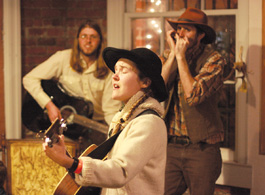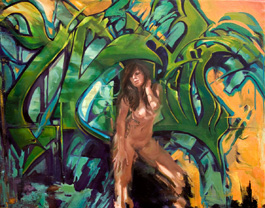home | north bay bohemian index | news | north bay | feature story

Photograph by Gabe Meline
SING OUT! Kyle Martin, Anna Jennings and Joshua Stithem performed at last month's Hootenanny.
Silver Lining Special
How art and music are surviving—and flourishing—in the Great Recession
By Gabe Meline
The floors are covered in sawdust, the rafters strung with clotheslines and draped with vintage linens. Buster Keaton films screen against the high brick walls, while string bands play folk songs on the low, fencepost-dotted stage. Gutter punks, hippies, performance artists, puppeteers and culture vultures alike nosh on cornbread, barbecue and offerings from the "Free Pie" table, while in the adjoining room, a young girl in rags leads a sing-along of "Oh! Susannah."
On this night at the North Bay Film and Art Collective in Santa Rosa's Railroad Square, hundreds of people are here for the Hootenanny, standing shoulder-to-shoulder to watch live music, share food, learn songs, watch films and participate in the creative arts. Just about everyone—from officially slated performers to impromptu singers, to those in dustbowl garb and people lugging in free pie—are in on the act. And when everyone's in on the act, it stops being an act and starts being community.
The undercurrent to the Hootenanny, both aesthetically and realistically, blew through the dusty rafters as plain as a tumbleweed. The Great Recession is here to stay, and to no small amount of surprise, it's actually helping to foster a groundswell movement in the arts. "It's a motivation to create the experience," as Hootenanny co-producer Gio Benedetti puts it, "rather than create the income."
This could be no more apparent than in this 9,000-square-foot space that once housed the North Bay campus of the New College of California before that school's closure in 2008. And though former New College president Martin Hamilton tells of offers from interested parties to buy the property from owner Peter Gabel—whose mother Arlene Francis routinely starred on the 1960s quiz show What's My Line? and whose father Martin Gabel acted in such films as Harvey and Marnie—none of the intended uses have aligned with the goals of what's known as the Arlene Francis Foundation.
"We talk about the collapse of capitalism, the collapse of the arts, the collapse of New College," Hamilton says. "It slipped away just as things were really falling apart in the whole country. So it's very tender for us. A bunch of us had committed our lives to social change and everything that New College stood for. In rethinking our lives, as we've gotten old, how to take this building and use it in a way that speaks to our hearts?"
Last year, Hamilton's neighbor Eric McIntyre proposed managing a multicultural arts center in the space, and along with Dave Fields, Jessica Barry and Celeste Turconi at the events helm, the Collective has since housed punk shows, burlesque performances, an international film series, art shows, food events and more since September of last year.
It's a reinvention that couldn't have happened without everything having gone to hell a couple years ago.

themainloop.com
'KALEIDOSCOPE A' Painter Sergio Lopez created this large oil and acrylic for the local monthly Kaleidoscope art party.
"The North Bay Film and Art Collective is a somewhat spontaneous communal response to having this great building and trying to have some phoenix-like experience," Hamilton says. "We have interests in everything that can connect people to their souls, to help people see each other as real people, and that our problems are solvable if we get together and work them out in a good way that doesn't mean you have to tear each other apart."
Over in Napa, a young collective is working toward the same opportunity. Wandering Rose's Olivia Everett, 23, says teenagers in Napa used to graduate and leave town to find careers. "But the economic downturn has brought people back to Napa," she says. "Graduating into a recession, a lack of jobs—people returned home. It really left this group of people here who decided they wanted to make something of it."
Everett and fellow Arts Council Napa Valley staffer Christy Bors have committed to founding an all-ages venue in order to bring together the sudden explosion of young bands and artists in Napa. The two even combed through city and county laws to find ordinances that impeded their goal, such as a zero-decibel noise policy after 10pm and antiquated rules for dancing. "We put together this ginormous ordinance review—it was 26 pages long," says Everett, who presented it to the city council with encouraging results; she's meeting with city planners to hopefully overturn a few of the ordinances.
Working with the Nest's Ann Trinca, the all-ages venue project called Artist Tree is throwing the Independent Culture Fair, à la the Maker Faire, in May and hosting community meetings at Bloom Hair Salon on Main Street. "Just four walls and a roof would be all we're asking for," Everett says, hoping to find vacant real estate for visual art, sculpture, performance, a zine library, music and meetings, similar to what Santa Rosa has done with its innovative floating Phantom Gallery project. "We think that it could bring vibrancy to the areas that don't have a lot going on in terms of tenants, and can be beneficial to the landlords, beneficial to the artists and in general beneficial to the community. So we're really stoked on this."
That exact setup is in place at a small building on Third Street in Santa Rosa, where Swensen's ice cream parlor stood for years before morphing into a series of Mexican, Chinese and seafood restaurants. For the last eight months, it's been vacant, except on the first Friday of every month when hip-hop choreographer Gabriel Francisco, DJ Jimmy Esquivel and promoter Roman D'Argenzio turn it into Kaleidoscope, a swirl of dance, live street art, DJing and music. The event's been packed for two months straight, thanks to Roman's father, local real estate agent and property owner Dino D'Argenzio, who says that opening shuttered doors to the arts is a two-way benefit.
"Imagine a vacant storefront," D'Argenzio explains. "It's kind of depressing-looking. Whereas when you see a space, even if it's under temporary use, and people come to it for an event, it's a positive, optimistic feel. It just adds a different energy to the space. So whatever we can do to help out organizations in the area on a short-term basis, even though it costs us money in utilities, cleanup and a little bit of maintenance, it's a way of us giving back to the community."
As a booker, Esquivel is happy to help D'Argenzio bring people together from different parts of the arts community, and emphasizes that none of the artists or DJs at Kaleidoscope expect to get paid; they're content with the exposure, experience and vibe. "The community that we have here is beautiful," he says of the underground arts, without grandstanding. "We need to feed into it. It all starts with us, every individual."
Of course, it's not beautiful when you can't buy groceries. On the first of the month, Theresa Hughes has $20 in her pocket. A clothing pattern-maker by trade, she's seen revenue dry up even while her creative well remains brimming. She's just back from meeting with a designer in San Francisco, the first job offer in months, while around her home hang huge hand-painted signs and set pieces, beautiful pieces of art she created as the visual and props coordinator for Santa Rosa's Great West End and Railroad Square Handcar Regatta when she was out of work.
As a free event, the Regatta is fueled by an army of volunteer sweat, and "at the end of the day what ends up happening is all of us work for free," says Hughes. "I think I got $800 total for the props last year, and that reimbursed me for supplies." Opportunities arose, though. Hughes' Regatta art caught the eye of Les Claypool, who commissioned her for custom signs for Claypool Cellars and a huge folding locomotive stage set for his New Year's Eve show at the Fillmore Auditorium.
If she had been employed the way she was 10 years ago, at a women's clothing company in Berkeley, Hughes wouldn't have had the time to sculpt the visual aesthetic for the Regatta. And though she's painting her house for rent credit and teaching weekly sewing classes in her living room to get by, she wouldn't change the experiences she's had in the downtime. "I feel like it's all facilitating something new," she says. "In a way, the recession is pushing us out of our comfort zone into trying something different. Because we have to."
That "something different" may well be critical acclaim. The rudimentary aesthetic of the Great Recession so fascinated Sonoma State University art history professor and gallery director Michael Schwager that he's co-curated "Sideshow," on display at the SSU Art Gallery with installations, signs, clothing and kinetic sculpture from Handcar Regatta artists. Schwager has a mainstream art background, but acknowledges the Zeitgeist current to the economic downturn in emerging artists using glue, nails, felt and thread.
"There's a certain modesty about the materials, and in some ways there's an informality about the presentation," he says. "It's not fussy or pretentious, the way some parts of the art world are. And certainly, in this particular exhibition, there's a kind of nostalgia about the turn-of-the-century into the early 20th-century aesthetic."
When underground art informed by hunger makes it into mainstream galleries nationwide, is it then a movement? "The days of the movements, and someone leading a movement, and the critic writing about a movement may be gone," Schwager muses, "which is, I think, to the betterment of the art world." He adds that he's seen it increasingly cropping up in galleries and museums in the last few years.
"Whether they all see it as nostalgia for the 1930s, or if it's just because jobs are scarce, money's scarce, materials are more easily scavenged than purchased, it's happening," Schwager says. "Is this aesthetic going to push out painting and printmaking, photography and sculpture? That's unlikely. But I think it's going to find a place somewhere at the table. It probably already has."
Send a letter to the editor about this story.
|
|
|
|
|
|